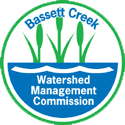News
Golden Valley residents unite to make a difference: rain garden offers pollution and drainage solutions
Mon, Jul 19, 2021Golden Valley residents unite to make a difference: rain garden offers pollution and drainage solutions
Did you know that when it rains, it pollutes? That’s because water that runs off hard surfaces—such as streets, parking lots, roofs, or driveways—is carried by storm sewer pipes to nearby lakes, creeks, or wetlands. But three neighbors in Golden Valley are helping minimize this pollution as well as help solve decades-long drainage problems by building a rain garden.
Brenda and Kevin Johnson and Lauren Salvato started building a rain garden together in May 2020, with the help of some other neighbors, too. A year later, with assistance from a Hennepin County grant and the Minnesota Water Stewards Program, they finished the 400 square-foot rain garden that mitigates runoff the Johnsons receive from three neighbors’ houses and garages. To mark the occasion and educate their curious neighbors, they hosted a celebratory and informational event with tours of the new garden.
The U.S. Environmental Protection Agency estimates that pollutants carried by rainwater runoff account for 70% of all water pollution. Storm sewers were designed to prevent flooding, but not designed to prevent pollution from entering our waters. Rain gardens mimic natural hydrology by allowing water to soak into the landscape as it does in natural areas.
What makes a rain garden different from a traditional garden?
Rain gardens are strategically placed to intercept runoff and designed to temporarily hold and soak in rainwater runoff. Rain gardens can remove up to 90% of nutrients and chemicals and up to 80% of sediment (dirt) from the rainwater runoff. Although called “rain” gardens, they are actually dry most of the time and are built to drain within a few days to prevent them from breeding mosquitoes. To ensure proper drainage, soils are typically amended with compost and sand.
What types of plants thrive in rain gardens?
As a rule, native shrubs, grasses, and perennials are best suited for rain gardens, because they are more tolerant of unfavorable growing conditions, such as being flooded one day and dry for weeks until the next rain. Plants that can handle having “wet feet,” such as blue-flag iris, cardinal flower, and dogwood, are generally happy in the bottom of rain gardens, whereas most other native plants prefer more consistent soil moisture can be planted on the sides of the rain garden.
What’s the best place for a rain garden?
Although an existing low-lying area might seem like a natural spot for a rain garden, it is better to avoid these areas to ensure proper drainage. Staying at least 10 feet from a house and 50 feet from a septic system is also recommended. Water can be routed to the rain garden above ground or below ground using drain tile or corrugated pipes. A typical rain garden for a residential home or small building is between 100-400 square feet. Regardless of the size, each rain garden can make an impact. To learn more about rain gardens, visit bluethumb.org.
Written by Dawn Pape on behalf of the Bassett Creek Watershed Management Commission (BCWMC), a local unit of government comprised of the nine cities that drain to Bassett Creek, focused on protecting water. BCWMC is a member of the West Metro Water Alliance. www.bassettcreekwmo.orgA rain garden is simply a bowl-shaped garden that captures rain and snowmelt to help filter out pollutants in stormwater so it doesn’t enter area lakes or creeks.
Properly designed rain gardens:
· Beautify your landscape
· Reduce water pollution
· Reduce flooding and erosion
· Help protect communities from flooding and drainage problems;
· Provide valuable habitat for birds, butterflies and many beneficial insects.
· Protect fish and other aquatic animals
Rain gardens DO NOT:
· Attract mosquitoes
· Hold water for more than 2 days (if built properly)
· Require more maintenance than other gardens
· Cost a lot of money to install

